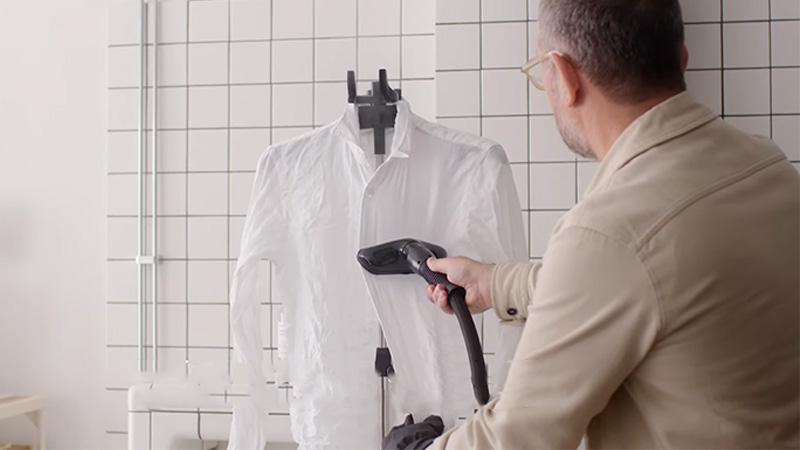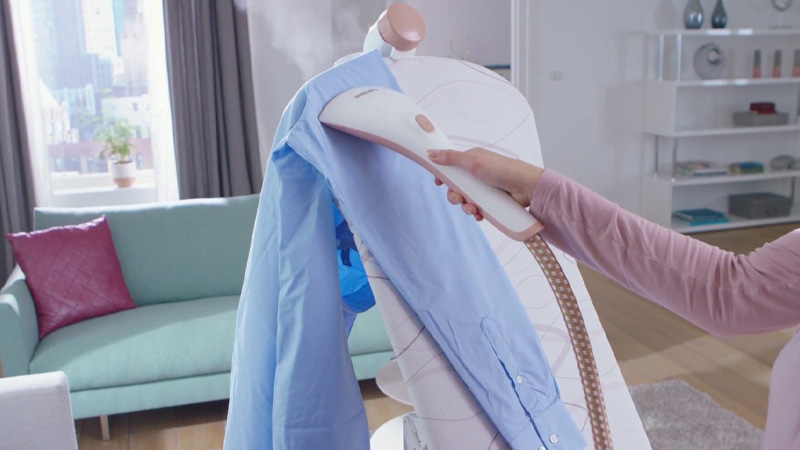In the world of garment care, clothes steamers have emerged as a versatile and convenient alternative to traditional irons. They offer a quick and efficient way to remove wrinkles, refresh fabrics, and even sanitize your clothes.
Whether you’re a seasoned pro or just stepping into the world of garment steaming, this guide is your gateway to mastering this essential tool.
In this guide, we will take you through the ins and outs of how to use a clothes steamer. From choosing the right steamer for your needs to steaming different types of fabrics, handling delicate garments, and tackling stubborn wrinkles, we’ve got you covered.
Say goodbye to the hassle of ironing and embrace the convenience and versatility of garment steaming. Let’s dive in and transform your wardrobe with wrinkle-free elegance!

How to Use a Clothes Steamer?
Using a clothes steamer is a convenient and efficient way to remove wrinkles, freshen up fabrics, and maintain the appearance of your clothing.
Whether you’re new to garment steamer or looking to refine your steaming skills, this comprehensive guide will walk you through the steps to use a clothes steamer effectively.
Materials You’ll Need
Choose a quality garment steamer suitable for your needs and fabrics. There are handheld and standing steamers available, each with its advantages.
Always use distilled or purified water in your steamer to prevent mineral buildup that can clog the machine. You can either hang your garment on a hanger or lay it flat on a clean surface for steaming.
Prepare Your Steamer
Fill the steamer’s water reservoir with clean, distilled water to the indicated level. Be sure not to overfill. Depending on the type of steamer, follow the manufacturer’s instructions to assemble and set it up. Ensure it’s placed on a stable surface.
Turn On the Steamer
Plug in the steamer and turn it on. Most steamers have an on/off switch or button. Wait for the steamer to heat up; this usually takes a minute or two. You’ll know it’s ready when steam starts to escape from the nozzle.
Hang or Lay Out Your Garment
Decide whether you want to steam your garment while hanging or on a flat surface. For hanging, use a sturdy hanger and hang the garment on a hook or rod. For a flat surface, lay the garment on a clean, flat table or bed.
Test on an Inconspicuous Area
Before steaming the entire garment, it’s a good practice to test the steamer on a hidden or inconspicuous area to ensure it doesn’t damage the fabric. Hold the steamer nozzle a few inches away from the fabric.
Start the Process
Gently pull the fabric taut with your free hand, and move the steamer in a downward motion, from the top of the garment to the bottom.
Keep the steamer nozzle close enough to the fabric for steam to be effective but not so close that it saturates the fabric. Hold stubborn wrinkles with your free hand and direct steam towards them until they relax.
Work on Different Sections
Divide larger garments into manageable sections, working on one section at a time. Ensure you steam both the front and back sides of the garment, especially for items like shirts and dresses.
Pay Attention to Delicate Fabrics
Delicate fabrics like silk or chiffon require special care. Keep the steamer nozzle further away from these fabrics, and use a gentle touch to prevent damage. Be patient and thorough, and make multiple passes if necessary to ensure all wrinkles are removed.
Handle Collars, Cuffs, and Pockets
Pay close attention to areas with collars, cuffs, and pockets. Use the steamer nozzle to target these areas and smooth out wrinkles.
When steaming suits or jackets, start with the sleeves and then move to the body of the garment. Keep the steamer nozzle moving to avoid over-saturating one area.
Finish with a Final Pass
Once you’ve steamed the entire garment, do a final pass to ensure all wrinkles are gone. Hang or lay the garment to air dry for a few minutes, allowing any residual moisture to evaporate. Turn off the steamer and unplug it from the electrical outlet.
Let Your Garment Rest
After steaming, it’s a good idea to let your garment rest for a few minutes to cool and dry. This helps set the fabric and ensures it’s ready to wear. Examine your garment for any missed wrinkles or areas that need touch-ups. Steam those areas as needed.
Clean Your Steamer
Once your garment is wrinkle-free and has cooled down, hang it on a hanger or fold it neatly to store or wear. After each use, empty any remaining water from the reservoir and allow the steamer to cool completely.
Periodically, follow the manufacturer’s instructions to clean and maintain your steamer to ensure its longevity and efficient performance. Congratulations! You’ve successfully learned how to use a clothes steamer to achieve wrinkle-free, freshly pressed garments.
How to Choose the Right Clothes Steamer?

Choosing the right clothes steamer involves considering your specific needs and preferences. Here are some key factors to keep in mind when selecting the ideal steamer for you:
Type of Steamer
Handheld steamers are compact and portable, ideal for small spaces or travel. They are best for quick touch-ups and smaller clothing items.
On the other hand, standing steamers are larger and provide more steam capacity. They are suitable for steaming larger garments, such as dresses and suits, and are often preferred for home use.
Steam Output and Capacity
Look for a steamer with adequate steam output and capacity to suit your needs. Higher wattage typically indicates more powerful steam production.
For frequent use or steaming large quantities of clothing, choose a model with a larger water reservoir to avoid frequent refills.
Continuous Steam vs. Burst Steam
Continuous steam provides a steady flow of steam while you hold the trigger or button, making it ideal for extended steaming sessions. Burst steam delivers a powerful burst of steam with the press of a button, helpful for tackling stubborn wrinkles.
Durability and Build Quality
Look for steamers with durable construction and materials. Stainless steel or aluminum steam nozzles are preferable as they are less prone to corrosion. Read user reviews and consider brands known for their reliability and longevity.
Size and Portability
Consider the size and weight of the steamer. If you plan to travel with it, a compact, lightweight model is essential. For home use, a larger standing steamer may be more suitable, as it offers more steam capacity and convenience.
Water Reservoir Type
Some steamers have removable water reservoirs that are easier to fill and clean, while others have integrated reservoirs. Choose a design that suits your preference and ease of use.
Cord Length and Heat-Up Time
Ensure the cord length is sufficient for your needs, especially if you plan to use the steamer in a room with limited power outlets. Faster heat-up times mean you can start steaming your clothes sooner. Choose a steamer that heats up within a few minutes for convenience.
Steam Control Options and Special Features
Look for steamers with adjustable settings to control steam output, making them suitable for different fabrics and clothing items.
Some steamers come with additional features like fabric brushes, crease attachments, or lint removers. Consider whether these features are important to you.
Brand and Warranty
Choose a reputable brand with a good track record for customer support and product reliability. Check the warranty offered with the steamer, as it can provide peace of mind regarding potential repairs or replacements.
Set a budget that aligns with your needs and preferences. There are steamers available for a wide range of budgets, so you’re likely to find one that suits you.
Reviews and Recommendations
Read user reviews and seek recommendations from friends or online forums to learn about the experiences of others with specific steamer models.
If possible, visit a store where you can see and handle different steamers to assess their size, weight, and ease of use.
By considering these factors and assessing your unique needs, you can choose the right clothes steamer that will simplify your garment care routine and keep your clothes looking their best.
Whether you’re a frequent traveler or prefer steaming at home, there’s a perfect steamer out there to meet your requirements.
FAQs
Can I use tap water in my clothes steamer?
It’s best to use distilled or purified water in your clothes steamer to prevent mineral buildup that can clog the machine. Using tap water, especially if it’s hard water, can lead to reduced steaming efficiency and potential damage to the steamer over time.
How close should I hold the steamer nozzle to my clothes while steaming?
Hold the steamer nozzle a few inches away from the fabric. The exact distance may vary depending on the steamer model and the fabric you’re steaming. Be close enough for the steam to be effective but not so close that it saturates the fabric.
Can I use a clothes steamer on all types of fabrics?
Clothes steamers are generally safe for most fabrics, including cotton, silk, wool, and synthetics. However, it’s essential to check the fabric care label on your clothing to ensure it can be safely steamed. Delicate fabrics like silk may require extra caution.
How do I clean the steam nozzle of my clothes steamer?
To clean the steam nozzle, unplug the steamer and allow it to cool completely. Use a soft cloth or cotton swab dipped in vinegar and water solution (equal parts) to gently clean the nozzle. Be careful not to damage or scratch the nozzle during cleaning.
Can I use a clothes steamer on suits and jackets without damaging them?
Yes, you can use a clothes steamer on suits and jackets. Start by steaming the sleeves and then move to the body of the garment. Keep the steamer moving to avoid over-saturating one area. Steaming is generally gentler on fabrics than traditional ironing.
Conclusion
Mastering the use of a clothes steamer can revolutionize the way you care for your garments, making the process of achieving wrinkle-free elegance more efficient and convenient than ever before.
In this comprehensive guide, we’ve walked you through the essential steps and tips for using a clothes steamer effectively. By now, you’ve learned how to select the right steamer for your needs, the proper steaming techniques for different fabrics, and how to address various garment care challenges.
With this newfound knowledge, you’re well-equipped to make the most of your clothes steamer and ensure your wardrobe consistently looks its best.
Embrace the world of garment steaming, and you’ll find that it not only saves you time but also extends the life of your clothing by minimizing the stress caused by traditional ironing.
Say goodbye to wrinkles and hello to the convenience and elegance that a clothes steamer brings to your daily routine.
Leave a Reply